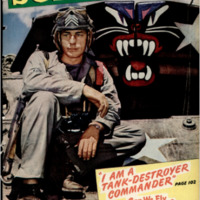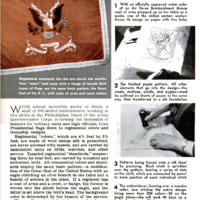How Regimental Colors are Made
Item
-
Title (Dublin Core)
-
How Regimental Colors are Made
-
Article Title and/or Image Caption (Dublin Core)
-
How Regimental Colors are Made
-
extracted text (Extract Text)
-
WITH almost incredible nicety of detail, a
staff of 100 skilled embroiderers, working in
two shifts at the Philadelphia Depot of the Army
Quartermaster Corps, is turning out thousands of
banners for military units and high officials, from
Presidential flags down to regimental colors and
troopship ensigns.
Regimental “colors,” which are 4% feet by 5%
feet, are made of wool unless silk is prescribed,
are never adorned with tassels, and are carried by
unmounted units on drills, marches, and other
service. Tasseled regimental “standards,” measur-
ing three by four feet, are carried by mounted and
motorized units. All ornamental colors and stand-
ards employ the same basic pattern—a modifica-
tion of the Great Seal of the United States with an
eagle clutching an olive branch in one talon and a
bundle of arrows in the other. If a regiment has
a coat of arms and a crest, or badge, the former is
woven into the shield before the eagle, and the
latter is set above the bird's head. The background
color is determined by the branch of the service.
The needleworkers sit at long wooden frames
reminiscent of the old-fashioned quilting frame.
As the banner is worked, the rollers to which it is
attached are turned, so that finished portions are
gradually wound back out of the way. Although
the work is necessarily of the most meticulous
kind, these expert embroiderers can turn out 15
regimental standards a month, as well as dozens
of other ornamental flags.
-
Language (Dublin Core)
-
eng
-
Date Issued (Dublin Core)
-
1943-10
-
pages (Bibliographic Ontology)
-
90
-
Rights (Dublin Core)
-
Public Domain (Google digitized)
-
Archived by (Dublin Core)
-
Matteo Ridolfi
-
Alberto Bordignon (Supervisor)
 Popular Science Monthly, v. 143, n. 4, 1943
Popular Science Monthly, v. 143, n. 4, 1943
 1.png
1.png
